The active development of technology allows today to create unique construction ...
|
|
The most important and laborious repair tasks are considered to be equalized work ... |
For a long time, the apartment renovation was limited to the arrangement of the interior, ... |
DIY windproof membrane
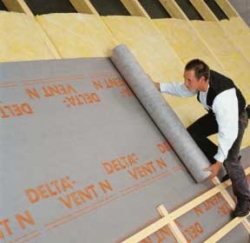
A windproof membrane is a rather new material in the construction market. Its demand began to grow with the peak of the popularity of building frame houses. But besides this, such a membrane material is very important not only when warming the walls of the house, but also when arranging a roof, where it became an integral layer of pie. This stage during construction work should be provided at the design stage or at the very beginning of the repair. The article will talk about how to choose a windproof membrane for the house and correctly mount it.
Content:
- The importance of hydraulic and windproof membrane for the house
- Advantages of using a windproof membrane
- A variety of wind protection materials for the home
- Manufacturers of vapor -permeable windbreaking membranes
- Types of construction membrane films
- Installation of a windproof membrane. Frequently asked Questions
The importance of hydraulic and windproof membrane for the house
- Regardless of what material the house is built of, when warming it, it is necessary to provide a windproof layer. Its task is to protect thermal insulation material from the effects of strong air flows, partially absorbing the air pressure. But, at the same time, without reducing the vapor -permeable characteristics of the material, which faces the facades of the house. Therefore, we can conclude that it is the windproof membrane that is the guarantor of the preservation of all important characteristics of the insulation, allowing you to extend its operational period.
- But do not forget that from the inside of the house you need to make a vapor barrier membrane film, which will protect the insulation from water vapor. When getting wet, he immediately worsens his properties and high heat loss begins.
Tip: a windproof single -layer or two -layer membrane is used only on the outside, and a vapor barrier membrane from the inside of the house, as a finish layer before installation of drywall.
- The importance of using wind protection membranes is due to several factors. First of all, it is infiltration, that is, when warm air from the house passes out through very small cracks in the structure of the wall material. This is especially common in wooden houses, when the wood is drying out. The second reason is the blowing of the walls. Even dense materials such as brick or foam block have sufficient porosity to let air through themselves. The presence of a windproof film helps to cope with these shortcomings, and, without affecting vapor barrier qualities, stabilize the microclimate in the room.
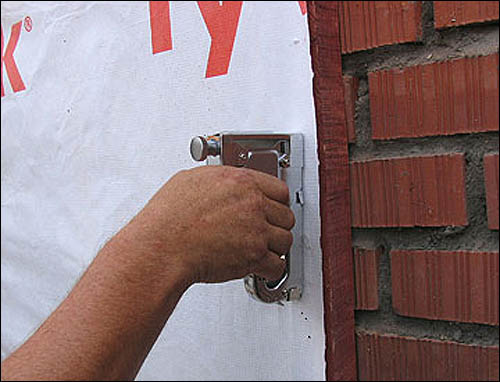
- In addition, the use of wind protection will protect the insulation from excessive humidity due to the resulting condensate, which often causes mold formation.
To date, there is a very wide variety of wind protection membranes for both foreign and domestic production on sale. All of them are very different in price and properties. According to their technical characteristics, windproof membranes for the house can be divided into:
- a vapor permeable film, contributes to the penetration of excess steam from the room, simultaneously protecting the insulation from rains and cold winds;
- vapor barrier filmFacing from the side of the dwelling. Its function consists only in the removal of steam, it cannot be attached outside;
- multifunctional membrane, Say her name for yourself. Despite the apparent convenience, they use it much less often.
Advantages of using a windproof membrane
- Environmental friendliness of the material. It is absolutely harmless to both humans and the environment.
- Fire resistance. It is achieved thanks to special additives that are in its composition. They allow combustion.
- Ease of use, easily mounted at any time of the year and does not require personal protective equipment.
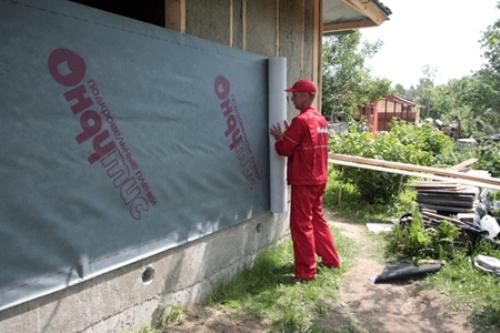
- High technical characteristics. So, it is resistant to ultraviolet, moisture resistant, elastic, resistant to mechanical damage and severe temperature changes.
- Duration of operation. He does not lose its properties for many decades.
Depending on what goals they want to achieve, a windproof film is attached to the walls of the houses, roof or on the ceilings of attic floors.
A variety of wind protection materials for the home
- Not so long ago, it was not to find special wind protection membranes on sale, but there was a necessity in the local material. Therefore, there are several alternative materials that are acceptable for use, although today it is not recommended. Although their cost is lower, their characteristics are significantly inferior to new high -tech materials.
- Perhaps the cheapest of all possible materials for wind protection of the walls is permamine. But, despite its low price, its appearance is so unattractive that it is most often made as a temporary solution with further dismantling.
- Until now, in the private construction of small houses, an ordinary plastic film is used as wind protection. But, due to very low vapor-permeable properties, excess moisture can accumulate in thermal insulation material, leading to sad consequences. The vapor permeability is important not only for the insulation itself, but also for the design of the walls, especially when it comes to a wooden house.
Manufacturers of vapor -permeable windbreaking membranes
Ondulin
This brand occupies one of the leading places in the market of wind protection membranes. It has been known for more than 25 years, during which it has established its high quality its products. The hydro-light-linked film is sold under the name Ondutis and, depending on the purpose and properties, is produced in several items:
- SA 115 This insulating material is a vapor permeable membrane, which is able to retain moisture and gusts of wind, while it does not rot and has high resistance to the gap and the effect of ultraviolet radiation. It is used to protect insulated structures, walls or roofs from condensate formation, atmospheric moisture and strong winds;
- And 120 Also suitable for use on wall and roofing structures. A distinctive feature is a higher indicator of solar radiation resistance. It is usually sold by rolls with a width of 1.5 m and 50 m long.
- And 100 In fact, the analogue of the previous, but cheaper. This is due to less strength and restrictions on the temperature regime of operation.
Isospan
This is a great combination of price and quality, so it can be bought at any construction store. The windproof membrane isospan is quite universal and suitable for use in insulated roofs with a coating of any roofing material: metal, natural tiles or bitumen tiles.
On sale, in addition to the most famous and popular models, there are products with increased fire -resistant qualities. Special antipypees in the fabric itself help to achieve this, this is able to protect the structure from the fire, both during construction work and during operation. Although its price is higher, but in some cases fire requirements allow only such a membrane to use.
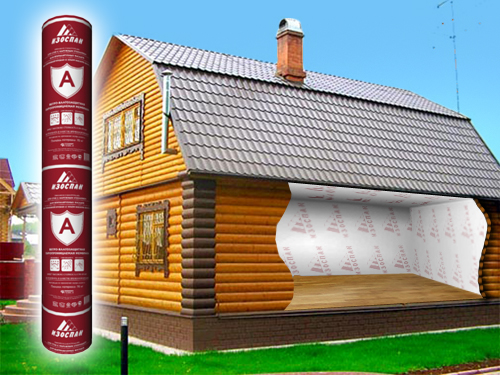
The isoospan was constantly improved, which allowed us to achieve a number of advantages over other analogues:
- compactness and small weight. This is the presence of small rolls that are easy to transport even in public transport;
- convenient sizes. Allow you to mount the material even to one person, but at the same time they will not create too many joints;
- high strength characteristics. They make possible work even under adverse weather conditions, while the risk of tearing the material is minimized;
- low price. Given the large film consumption, this is an important component when choosing;
- elasticity, resistance to UV rays, temperature changes, etc.
Depending on the specific construction goals, you can also choose the most acceptable option from the ruler that the manufacturer represents:
- Isospan a This windproof is intended for external use. It is attached to the wall of the house under the ventilated facade or under the roofing. Its purpose consists in protecting the structural and insulation elements from wind and water. An improved isoospan is also sold with fire -retardant properties;
- Isospan am This is a two -layer membrane material with high vapor permeable properties. It will perfectly protect the insulation from condensate, atmospheric humidity and weathering. This is achieved due to the special structure of fabric, the creation of which became possible only when using modern technologies. This guarantees high waterproof characteristics during prolonged operation in the most extreme weather conditions;
- IsospanAs Although the most expensive in its line, as it is a three -layer material, thanks to the installation method, can reduce costs. So, it is allowed to be attached directly on top of the insulation, without equipment of the crate for the gap.
Windwear membranes Rockwool
These are vapor-permeable wind and moisture protection materials that are produced in different brands. The choice depends on the specific conditions and the goals that must be achieved. They are sold in standard rolls of 70 m2.
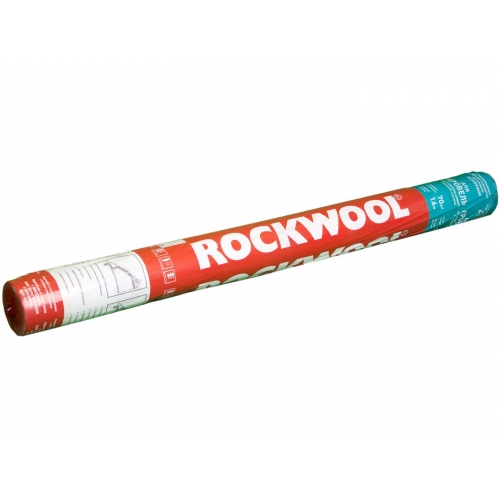
- Rockwool roof. This is a two -layer membrane, meets all the basic requirements. Successfully removes condensate from the roof and protects the insulation from the wind. When applying it, you should definitely do a gap to 5cm. The width of the roll is 1.6 m, therefore, it should be placed on the roof with horizontal stripes with a gap of at least 15 cm. The upper strip of material is laid with a slope from the ridge of 5-10 cm.
- Rockwool Partitions. It is chosen if the facades of the house were insulated outside. It serves as a protective layer between thermal insulation material and external siding or any other material. It is attached directly on top of the insulation, clutching with rails, to which decorative wall cladding is further attached.
- Rockwool Partitions with fire -retardant additives. It completely retains all the functions and the purpose of the previous type, but its composition contains special antipyrene additives that allow you to protect the structure from fire for a while.
Types of construction membrane films
All membranes for building a house can be divided into several main categories. So, depending on the structure of the material and its purpose, there are vapor -permeable and vapor barrier films.
Vapor barrier membrane
- It is always mounted only from the inside of the house, protecting the cotton insulation from the accumulation of moisture from condensate in it. For example, when arranging an attic roof, the insulation from the bottom is closed just with such a film. It may look different: in the form of a smooth paper film of high elasticity and strength with a glossy side or in the form of an aluminum film with a foil side.
Tip: The presence of vapor barrier on wall and roofing structures of the house creates the effect of thermos. This is good for energy conservation during heating, but at the same time, humidity in the room increases greatly. Therefore, they must install supply and exhaust ventilation systems in them.
- To protect metal roofing materials, such as metal tiles or corrugated board, special membrane materials are available. These films have an anti -condensate coating that protect the metal from corrosion. The principle of its operation is the structure of coating one of the sides, it is rough to the touch, as it is an adsorbing layer that absorbs condensate rising from the room. Between such a membrane and the insulation, a ventise is left 2-5 cm.
Vapor -permeable windproof membranes for walls and roofs
- They are used outside the buildings over the insulation under facing or roofing material. In addition to the fact that it successfully protects the soft insulation from damage by its wind, but also contributes to an additional waterproofing layer. Since windproof membranes are a kind of buffer between thermal insulation and the external environment, it is important that they pass all possible moisture from the room to the ventilation gap. This is possible due to the presence of a very petty perforation, which is invisible to the naked eye. From this it follows that the higher the throughput of the windproof membrane steam, the more efficient it will work. According to this principle, it is divided into: diffusion, superdiffusion and pseudo -diffuse.
- Pseudiffusion Materials in most cases are used in the construction of the roof. This is due to their good waterproofing properties and successful operation with properly organized ventilation gap. But laying such a windproof membrane on the facades is not recommended due to low vapor permeability characteristics. Her pores are so small that they can easily clog with dust in strong air flows and stop working.
- The best windproof membranes for the walls of the house are diffusion and superdiffusion.Their vapor -permeable properties are so good that you can not worry about clogging. Due to the large number of pores of a rather large size, manufacturers guarantee the correct operation of such materials even without arranging a crate for ventilation on top of them.
- Separately, it is worth mentioning such a form of windproof films as voluminous diffusion membranes. This is a great option for roofing. They are rather dense mats up to 3 m in length and about 8 mm thick. Such volumetric polypropylene slabs are an independent layer that separates the insulation and coating of the roof without additional ventilation. This guarantees a qualitative discharge of condensate formed under the roof, extending the service life. For its fastening, ordinary nails are used, but the base for it can only be a continuous coating, for example from plywood.
Installation of a windproof membrane. Frequently asked Questions
- On which side to fasten the windproof membrane? If the house is insulated with mineral wool, then it is attached from the outside directly over the insulation. They also do when working on the insulated roof. If the roof is not insulated, then instead of wind protection is attached vapor barrier from the bottom of the rafters. When the walls of the house are insulated only from the inside, then the vapor barrier film is mounted only from the side of the room.
- Which side to lay the membrane correctly? As a rule, all membrane fabrics have the front side, which is quite difficult to distinguish and have to look closely for a long time. But you can’t make mistakes, since the location will depend on how it works. So, roofing anti -condensate wind protection is attached to the absorbent side inside the room. To date, well -known manufacturers of diffusion materials have begun to mark one of the parties and indicate in the instructions on the rolls, how exactly it should be placed.
- Is a ventilation gap needed? In most cases, it is needed. For example, when arranging vapor barrier from the side of the dwelling between it and drywall, it is necessary to leave a gap of 2-3 cm. But windproof diffusion materials can be attached without additional ventilation between the insulation, but it is imperative to make it between the finish cladding of the building. The frame from the slats is attached vertically so as not to prevent air flows. The roofing anti -condensate film should have a 5 cm lock on both sides.
- How much to make an overlap of paintings of a windproof membrane? The most famous manufacturers on their products make a marking tape, which indicates the optimal size of the overlap. For walls, in most cases, it varies from 10 to 20 cm. But when installing the roof, this indicator depends on the degree of the roof tilt, the less the slope, the greater the overlap should be left. In the area of \u200b\u200bthe joint with the skate, windproof should have a overlap at least 20 cm, and on yendov up to 30 cm. Often, in these places it is recommended to mount an additional layer in the form of a strip with an overlap on both ramps of 40-50 cm.
- Do I need to glue the joints of a windproof membrane? This is a prerequisite that all manufacturers prescribe. This is the only way to achieve the absolute tightness of the joint. For these purposes, any self -adhesive tapes are suitable, but it is best to use a construction reinforced tape. Although its price is significantly higher than the usual paper, but it guarantees excellent performance for many decades. You can also use it to repair the gap. But first, put the gasket in the form of a piece of wind protection inward, and then glue everything.
- How to fix the windproof membrane for the house?For tension and temporary fixation, a construction stapler is used. But this is only a temporary measure, the rails are necessarily firmly screwed on top, which will serve as a crate for further facing work. But with the further arrangement of hinged facades, the work will be more laborious. Initially, brackets for hinged panels are attached to the wall, after which the plates of thermal insulation material on dowel-grooves with gearboxes are mounted. After that, a windproof membrane is pulled on top and, applying to the wall, make slots for each bracket. And immediately, right through the heat-insulating material, they are attached to the wall on similar nails-gearboxes. Their number should be at least 5 pcs/m2. If the counterparts are not difficult to nail along the perimeter of the windows, then in places of joints with pipes, antennas, ventilations the edges are glued to bilateral tape or special rubber glue.
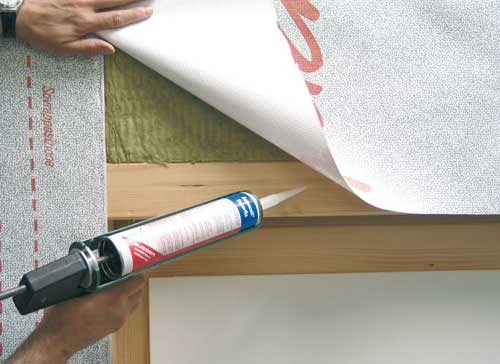
- How long can you not close the windproof membrane? Although manufacturers assure the stability of their materials to ultraviolet rays, this term is limited. So, after 5-6 months, the material begins to age losing its properties. Therefore, it is recommended to close wind protection as soon as possible with cladding after its installation. And also, if the windshield falls under prolonged rain, it gets wet and begins to let water to the insulation and to the elements of the construction of the house. Therefore, it is more convenient to make each wall separately, immediately mounting all the layers with facing, and not the whole house in stages.

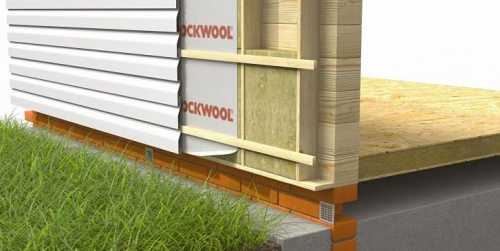
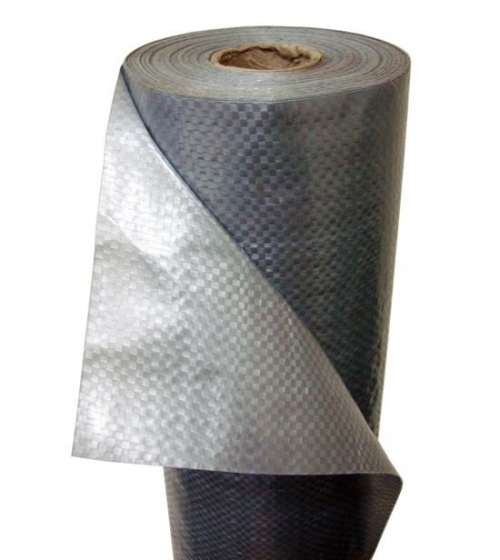
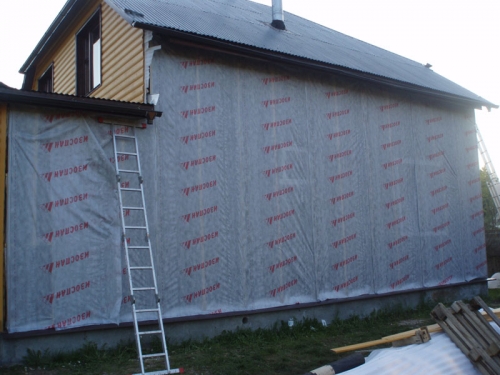
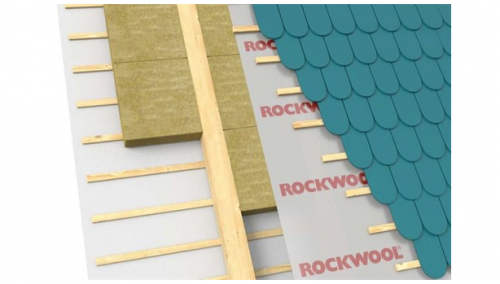
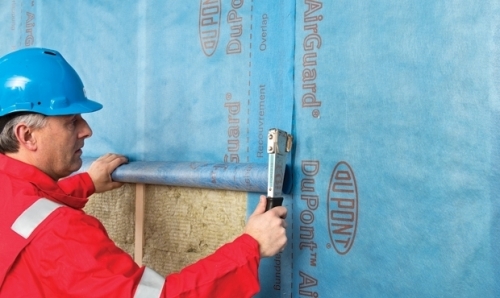
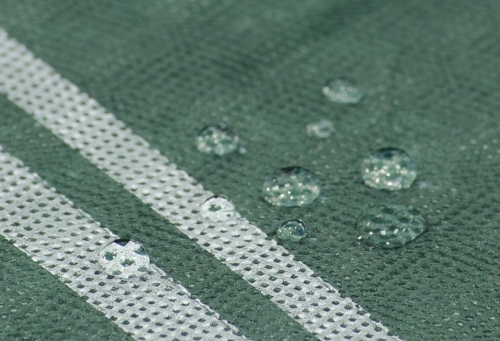
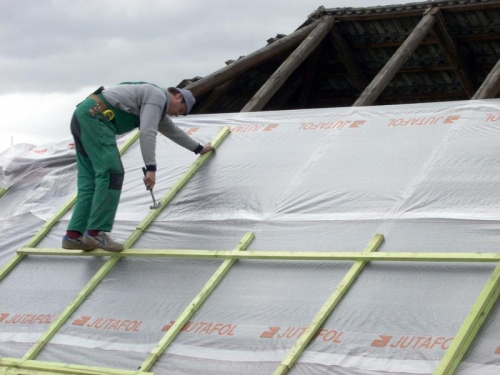

It is very important to understand that
It is very important to understand that an ordinary membrane will not protect your house from an unforeseen fire.
Therefore, it is best to use a non -combustible membrane. Its properties are similar to an ordinary membrane, and technical characteristics are much better. On my experience of choosing non -combustible membranes, I’ll say that it is not worth comparing them by certificates, since certificates are now made on every corner. Here, of course, you need to hold in your hands, look at the bend, density, etc. For himself personally, after he held in his hands samples of several non -combustible membranes, chose one - which really meets all the quality standards and fire safety requirements. I put 10 balls of a non -combustible membrane fibraizol NG.